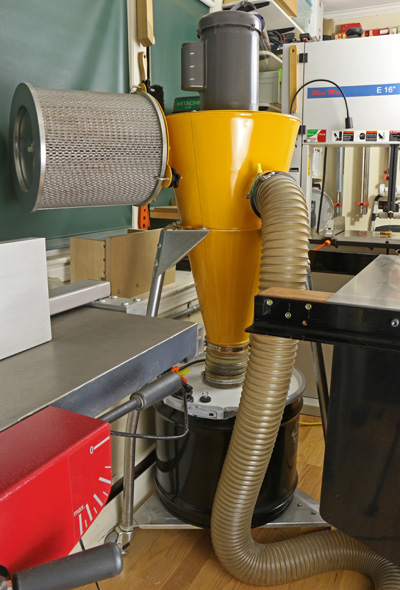
For many years, dust collection in my shop had been the basic bag-over-bag single-stage collector familiar to most of us small shop woodworkers. A few years ago I upgraded to the Oneida Mini Gorilla, a cyclone collector, and it has been excellent. I’ve received many inquiries about it from woodworkers considering upgrading their dust collection system, so I hope this report will be helpful.
A cyclone collector is more efficient that a single stage collector because it involves two stages of collection based on particle size. Here’s what happens. The impeller fan whips around the intake material in the big sheet metal cone that give these machines their characteristic appearance. The chips and larger dust particles that constitute almost the entire volume of the intake fall into the collection drum below the cone.
Thus, only the finest dust – the most unhealthful – gets passed on to the air filter, the cage-like cylinder sticking out the side of the yellow cone in the photo above. This permits the use of an incredibly efficient sub-micron pleated HEPA filter without it getting continually overburdened and clogged with debris.
What all this means is that my shop is cleaner, and more important, healthier.
The Mini Gorilla easily handles the biggest producers of chips in my shop, the Hammer A3-31 12″ jointer-planer and the DeWalt DW735 planer. The only limitation is the dust gathering efficiency at the source. Fortunately, the A3-31 and DW735 are great in this regard. The Minimax bandsaw is good while the Saw Stop table saw (vintage 2005) is just fair.
Oneida rates the noise produced by this machine at 76dB(A) at 10 feet. As a practical matter, it seems noisier than what I remember of the old bag-on-bag collector but it’s not bad and certainly not a deal breaker. The Mini Gorilla is very space-efficient – notice the motor on top of the cone – so its footprint is smaller than most small single-stage collectors.
It’s not cheap. The base price is now $780, according to Oneida’s website. A mobile stand or wall bracket, steel drum, and shipping push the total over $1 large.
Oneida’s website has details about the Mini Gorilla and the rest of their large line of dust collectors. This review is unsolicited and uncompensated.
Grunt machines like a good dust collector are not glamorous and there is a natural reluctance to invest in them. However, I think they support a sense of freedom in the shop because they take good care of the dirty work and produce a better working environment. That freedom, in turn, produces more creativity, which is what this is all about.
Next: How I set up the Mini Gorilla in my small shop.

Rob: Nice review. Interesting that you give it high marks for collecting output from your jointer and planer: I have been searching reviews of this unit and the one weak point that nearly everyone mentions is its poor performance for these two machines. I wonder what the issue is: just a drum that is too small? Phil
Phil,
That’s surprising to me. There’s really almost no debris to clean up after I use those machines. I don’t see how the size of the collection drum would matter but maybe the issue is at the connections to the machines.
Rob
Rob
So it may have been as simple as dissatisfaction with having to empty the relatively small drum more frequently than would be required with a full size unit. This would be more of an issue in production shops than in low volume hobby shops. It would be nice to have that true HEPA filtration: I suppose a few extra trips to empty the collection drum is a small price to pay to breath clean air in the shop.
Phil
Phil,
Yes, but I’ll have more on the drum emptying issue in the next post.
Rob